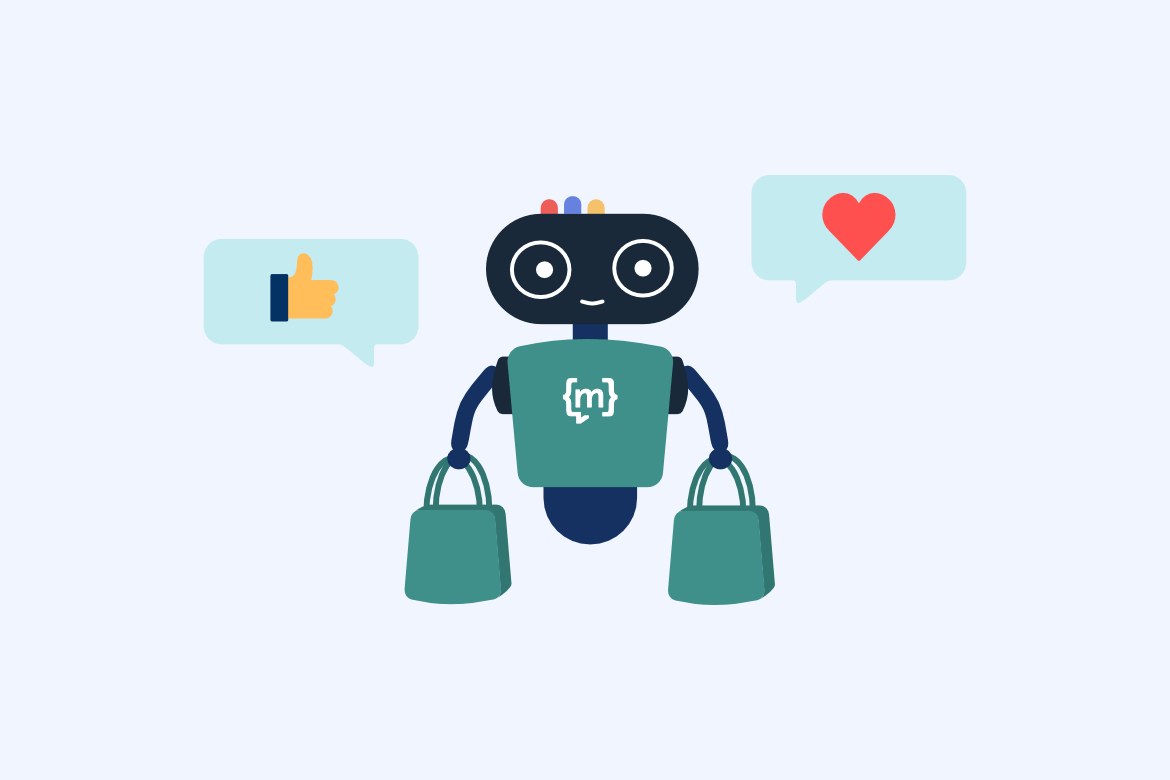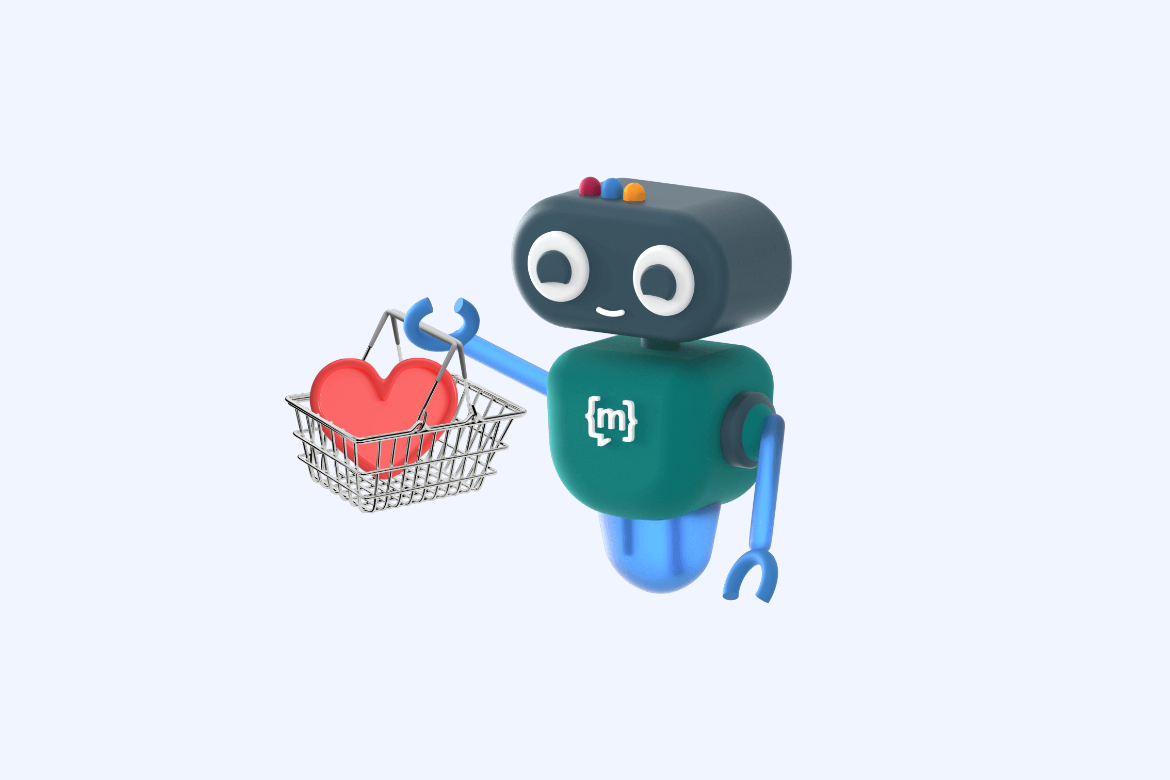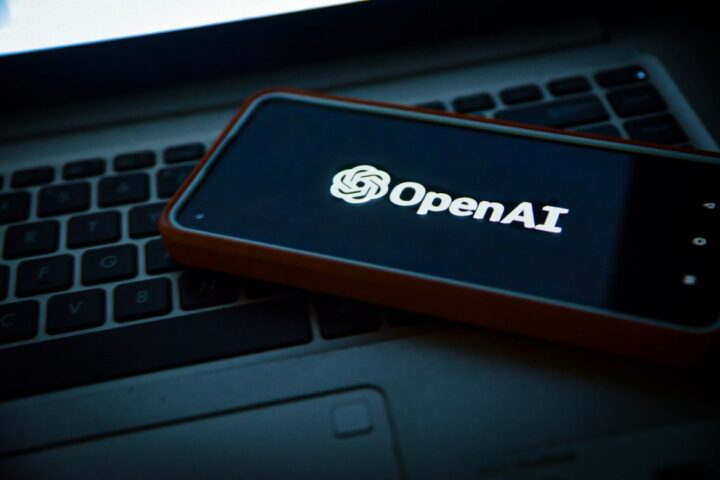5 reasons why e-commerce companies can benefit from AI chatbots + a successful best practice
Written by
Editorial TeamPublished on

This article highlights the various uses of AI chatbots in e-commerce. It presents possible use cases and potentials that show how online stores can successfully use chatbots to eliminate known problems such as shopping cart abandonment or to create positive effects such as increased engagement or more automated leads by providing users with helpful support and advice on products at any time.
For a glimpse of real-world practice, the approach of VELUX, a Danish manufacturing company that has achieved impressive results with a chatbot in e-commerce, is shown.
If there is one industry that benefits from the digital boom, or in other words could not live without digitalisation and the internet (as well as chatbots), it is e-commerce. The “E” in e-commerce stands for “electronic”, but in the meantime it could also stand for “everywhere”.
Thanks to smartphones, people can now shop almost anywhere and at any time. This makes it even more important for e-commerce companies to be present at all times; to appear user-friendly; to support customers when desired; etc. The list could go on and on. One thing is clear, however: Potential use cases for chatbot systems definitely exist in the field of e-commerce. Let’s start with the first point.
The helpful shopping assistant: For an effortless shopping experience
Chatbots offer the possibility to competently assist a customer around the clock, regardless of the type of product. Instead of clicking through numerous products, a user can engage in a kind of conversation with the chatbot – conversational commerce, so to speak.
When the user contacts the AI chatbot, it can make suitable product suggestions to the user based on the preferences asked. This process does not take long and can take place at any time.
Not every user finds it easy to navigate through the abundance of products and successfully navigate through an online shop. So it’s excellent if a chatbot can prevent such a user from bouncing off the page by providing quick assistance.
Of course, correctly filling out search forms can also lead to the desired product, but an AI chatbot has clear advantages over filtered searches. It is more comfortable and simple for the user.
A chatbot widget is usually easier to find than possible search filters and the most important point: an AI chatbot is interactive and learns. So AI chatbots can learn from every conversation by asking questions to better understand problems or getting feedback in terms of whether the conversation was helpful.
This is worth a lot, because not only does the chatbot become smarter, but the user also gets to their desired product more easily and quickly. In summary: A chatbot can significantly optimise the user experience.
Classic customer service: happy Customer & lower support costs
Just like an insurance company or a bank, an online store needs fast and attentive customer service. In the e-commerce industry, enquiries can arise on a variety of topics. An excerpt of possible customer queries can be:
- Dissatisfied with the goods
- Goods damaged
- Goods too small/big
- Goods look different from presented online
- Goods not yet received (e.g. requesting the consignment number)
- Payment
- Refund
- Redeeming a voucher (e.g. the voucher code does not work)
An AI based Chatbot can be trained for all these potential use cases. Nevertheless, it is important that e-commerce companies deal precisely with their communication goals in advance and name use cases so that the chatbot can be trained and specialised for precisely these cases.
AI chatbots offer the possibility to help customers with almost any request. And if that doesn’t work in exceptional cases, this can also be recognised by the chatbot and forwarded to a customer service employee.
The advantages that chatbots generally bring to customer service should also not be ignored – regardless of the industry: 24/7 availability, answers in seconds, relief of employees and thus the opening of new time slots.

Branding: Fascinate visitors with your brand
A chatbot offers the possibility to stand as a representative of a brand and thus to shape the brand and become a rising star itself. Chatbots can, if so desired, interact humorously, use certain wording or convey messages that are important to the company. All these things are essential to shape your own brand and optimise the brand image, if desired.
The e-commerce industry is very competitive. Thanks to search engines, users can compare prices and suppliers within seconds. The web makes suppliers virtually transparent, which means that users often no longer feel they belong to a brand or an online store, but simply shop where the product is currently cheapest. Therefore, from one perspective, it is important to offer excellent customer service, as already mentioned above, in order to prevent frustration and annoyance.
Another effective method is to bond the user to the brand. For this to succeed, various conditions must be fulfilled. Some of them are to gain the trust and sympathy of users. A chatbot can support this by acting in an image-compliant way. This can arouse positive emotions that lead to positive evaluations or generally form a positive resonance towards the company.
In this way, it is possible for a company to act through a chatbot instead of only reacting. In other words: to actively address a customer. Be it through a news update, a question about satisfaction or games such as a quiz. Chatbots can start a conversation with any customer at any time of day on any topic. Such proactive communication can optimise brand perception and loyalty over time.
No more Shopping Cart Abandonment
Or at least less than before. Those “Add to Cart, but no purchase” visits are a big problem for many online stores. Since the reasons vary, there are of course different solutions. One reason why a purchase is not completed is that the website visitor is distracted and leaves the online store more or less intentionally. A chatbot can take action at this point by actively addressing the user after a defined period of inactivity on the website and offering support, for example.
Gaining customer insights
What is going on in the mind of a user? How satisfied is a customer with his/her order? Companies rarely find answers to some questions, and in some cases this will probably remain the case. Because if a user or customer doesn’t want to communicate, it’s hard to change that. However, it can be made easier and bridged by proactively gathering feedback or by analysing the data of chatbot conversations. With the feedback that chatbots collect, a brand can improve its service or product. If, for example, the organic traffic of an online shop is very good, but the conversion rate is relatively low, the reason must be determined. This is where an AI chatbot can play a crucial role by collecting and evaluating customer insights in a targeted manner.
Even if the conversion rate is satisfactory, it can still be optimized further. Chatbots offer great opportunities to track and evaluate consumer behaviour. The system automatically generates insights about the users of the chatbot. This makes it easy to see whether customers are currently struggling with certain problems or whether a product is attracting more interest than usual – ideal for planning marketing processes or helping customers quickly or to draw better conclusions regarding the marketing of products.
What does it look like in reality? Best Practice: VELUX OSO
Of course, there are great real-world examples of many companies using an AI chatbot. One of them is the Online Sales Organization (OSO) of VELUX, an internationally known Danish manufacturer of windows. A couple of years ago VELUX established its new Online Sales Organisation, which is responsible for all B2C online sales of blinds (blackout, awning, roller pleated blinds) and roof windows through its websites as well as Marketplaces.
The challenge: high volume of user enquiries during peak seasonal phases and a high product complexity
As is often the case in e-commerce, the customer service team of VELUX OSO was faced with being repeatedly asked the same questions. What’s really significant here is seasonality: there are extreme peak phases at certain times of the year, resulting in a large volume of enquiries that is difficult to manage. It is however essential to respond to these enquiries, as (potential) customers would otherwise be lost.
The resulting goal: first of all the reduction of manual effort in the live chat.
Given the challenges mentioned above, VELUX OSO set itself the goal of substantially reducing the manual effort of customer communication that came about via the live chat. Reduction of manual effort in live chat should not however mean the live chat being unavailable or only partly available during peak phases.
Despite the reduced burden, the online availability had to be expanded, allowing users to submit questions at the weekend or in the evening. It also had to be ensured that sales-relevant enquiries would be appropriately pre-assessed then forwarded directly to the sales team. The main focus was rather on reducing the number of live chats, thus minimizing the manual burden.
The solution: a permanently active digital assistant that can answer questions capably
Given the limited personnel resources combined with the need for omnichannel customer service presence including email, phone and chat, there was a need for a solution that would reduce the overall support volume, provide users with quick answers, and do preparatory pre-assessment work.
To meet these challenges and reach the stated goals, VELUX OSO chose the AI chatbot solution from moinAI. Based on natural language processing (NLP) and artificial intelligence (AI), moinAI is able to understand, answer and pre-assess complex messages and forward them to the right person. All this happens automatically and around the clock. The AI chatbot also learns with every user conversation, refining itself via the Dreaming feature and suggesting new, chatbot user-relevant topics to the chatbot owner, in this case VELUX OSO.
The result: a digital assistant that reduces manual efforts and increases service quality
One of the biggest advantages is the optimization of the customer journey. Especially with a special and sometimes complex product range like VELUX OSO’s, it is key to help website visitors navigate and to offer them support and capable advice. The chatbot does this by answering questions around the clock, showing users the various products and sub-options.
Two further advantages that should definitely be mentioned relate to the mentioned live chat:
- Live chat can now remain online throughout the entire season, as there are always enough staff available, even during peak phases.
- And because the chatbot takes care of repeatedly occurring questions, employees no longer have to spend time dealing with them. This reduces burdens and ultimately leads to increased service quality, as employees can now focus on relevant and complex enquiries.
These developments have resulted in great numbers: For the UK website the manual responses to live chat enquiries were reduced by around 75%. Similar results were seen for the chatbot on the Germany and Netherlands websites. The number of manual responses in the live chat was reduced by about 91% on the German website and about 85% on the Dutch website.
And these are by no means the only results to be cited. An essential result, for example, is also the CSAT, based on user ratings in the chat, which is at 75%.
→ Want to get more information about the best practice VELUX OSO and their chatbot implementation? Download the free case study for more interesting insights and further KPIs.
A glimpse into the future: AI Chatbot – a technology that keeps getting better year after year
If possible, companies should not only consider integrating AI and automation into customer communication processes, but actually implement them successfully. After all, it can happen quickly and you are the last to go – which is particularly disadvantageous in the highly competitive e-commerce industry.
It is better to be one step ahead of the competition. Because especially with the younger generation, text-based chatting at any time, even or especially with companies, is more than a plus, it’s a requirement. Equip your business with the way to ideal customer communication to keep up with the evolving trends.
It is obvious that an AI chatbot significantly supports a company with regard to the development towards conversational commerce. And that’s very good, because good conversations are a key to success.The right customer communication has what it takes to make your brand stand out, to leave a lasting impression on users and customers, and to bind them to the brand.
→ Because after all, there’s just one thing that matters for users and customers: added value.
And that added value can be ideally transported via an AI chatbot. Be it simple and seasonal topics: Summer is just around the corner, and based on the search profile of a customer, you know which brands and designs she/he prefers – now the chatbot could proactively suggest a summer outfit of her/his taste to the customer.
Conclusion: Make it conversational – chatbots offer a better user experience, while reducing support costs at the same time
Chatbots simplify the lives of many people, whether on the company or customer side. For e-commerce companies, chatbots are a great way to get in touch directly with their customers and thus learn valuable insights and preferences directly. If you know your users well and can better assess their wishes, you can also increase your conversion rate and turn a user into a loyal customer. And smart chatbots are also a relief for users: they can make tedious searches easier and prevent page-by-page click-throughs, thus significantly improving the customer experience.
Sounds good? If you want to know how a chatbot could look and work in your company, order your free and individual demo made by one of the moinAI chatbot experts. Order now.

Laura Masbaum works as an Online Marketing Manager at moinAI [by knowhere]. moinAI is a self-learning AI chatbot solution made for digital customer communication of companies. The chatbot is based on AI and Natural Language Processing (NLP) and can be easily integrated into existing crm or live chat systems. Laura joined knowhere in 2019, her focus is, among other things, creating relevant content in order to introduce more and more people to the exciting AI chatbot technology and to change the way companies communicate with their customers in the long term.


